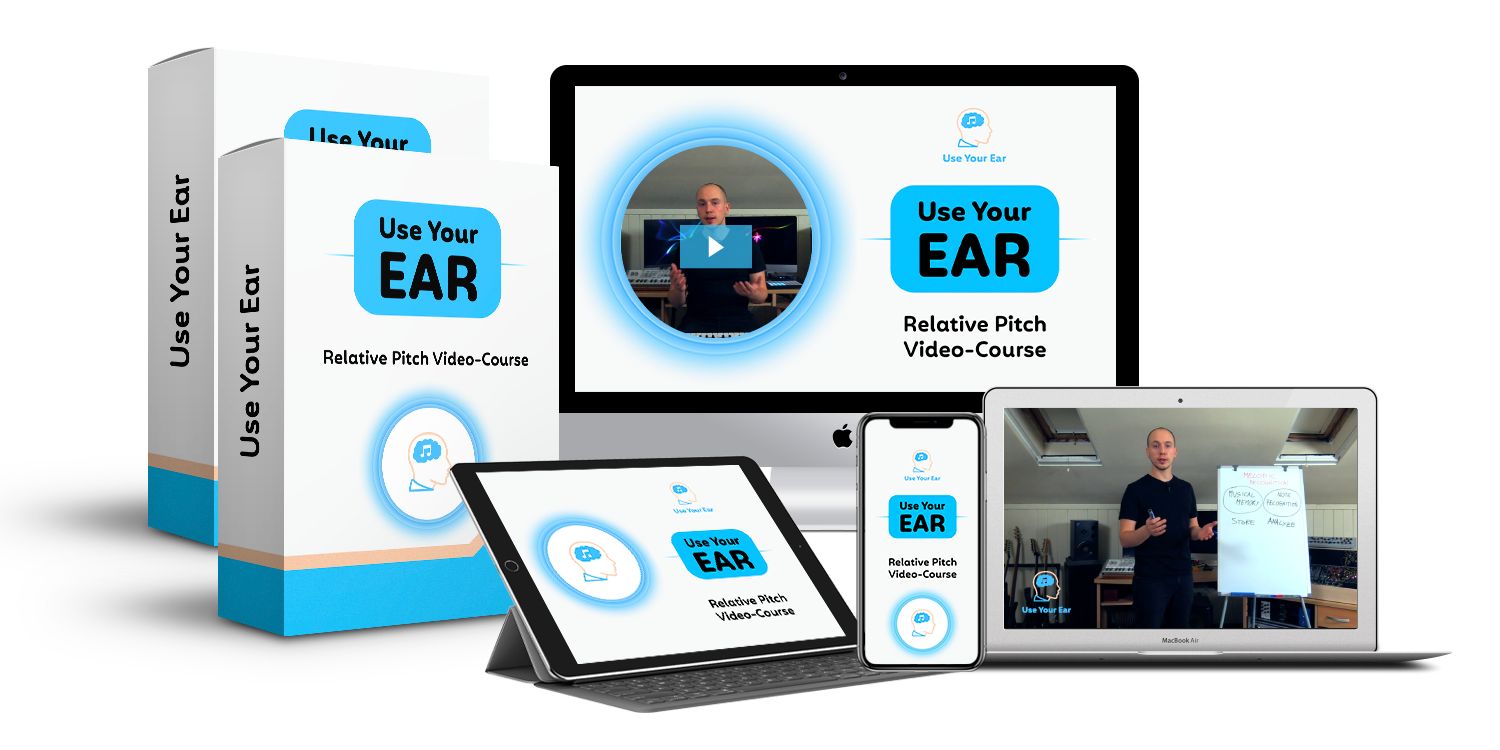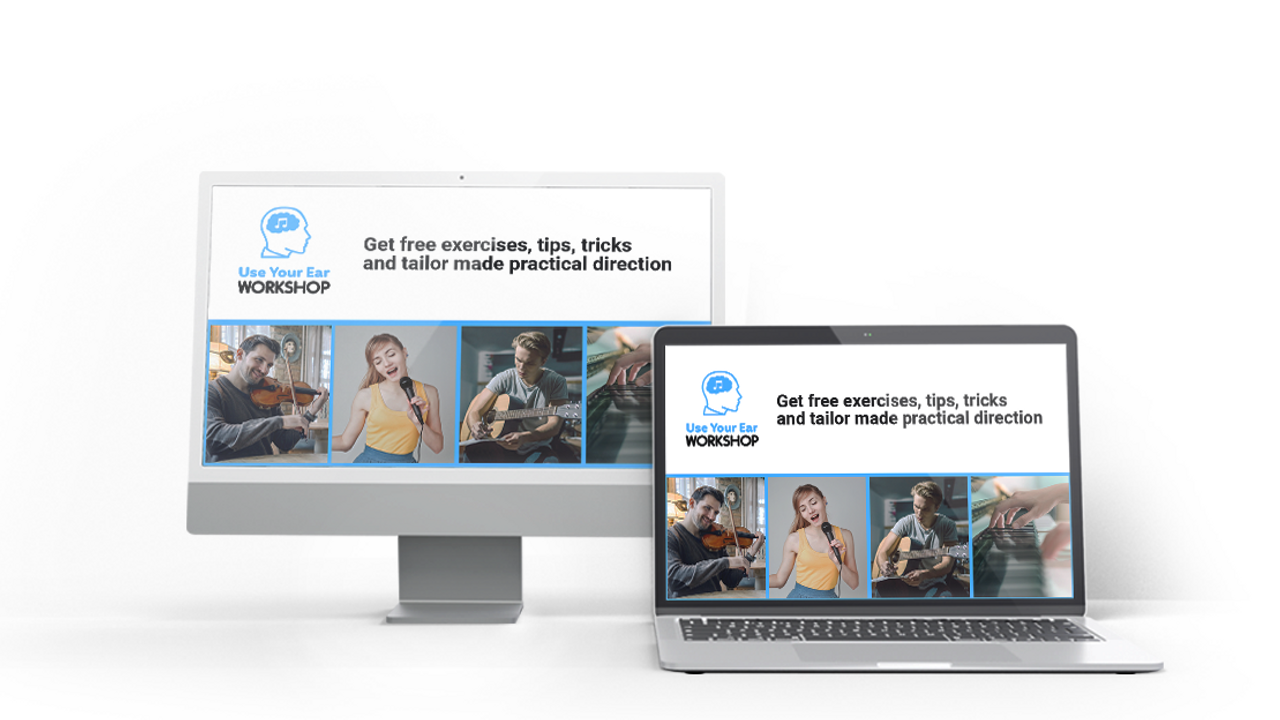Ear Training For Guitar Players
What is Ear Training?
Ear training is the process of developing the ability to recognize different musical elements exclusively by ear. Ear training encompasses a wide variety of sub-skills, each focusing on identifying specific musical areas such as pitch, chords, rhythm, melodies, scales, and harmonic progressions.
By learning how to recognize music purely by ear and through intuitive mental processes, musicians experience a much deeper connection and understanding of the music they play, write, perform, and listen to.

The importance of ear training for guitar players
One of the most important skills guitar players fail to develop is their ability to recognize music by ear through an effective ear training approach.
Many guitarists simply pick up the instrument because they aspire to play the music they love. They start learning their favorite songs, riffs, and guitar solos and usually progress to an intermediate level without being concerned with important theoretical and practical skill sets that are needed to become an excellent musician.
At some point during their learning curve, many guitar players realize that, despite their technical abilities and familiarity with certain repertoire, they haven’t dedicated the time to learn basic ear training skills and the theoretical concepts associated with them.
Developing your ear is such an essential part of becoming a great musician and fully appreciating the emotional depth and colorful nuances of the language of music. Imagine how powerful and liberating would be to instantly and intuitively recognize the music you are hearing in any given context.
Ear training for guitar players can help any guitarist be able to identify notes, scales, chords, rhythms, and chord progressions without using their instrument at all and, as such, should be one of the top priorities of your musical endeavors. Having a powerful ear is the key to musical freedom.

Effective vs ineffective types of ear training for guitar players
One of the most important aspects of developing your ears efficiently is to use the right ear training method. Many of the free exercises or strategies that can be found on the Internet are put together without a coherent system that focuses on gradually teaching you the right skills one step at a time. Let’s have a look at a couple of ineffective ear training exercises for guitar players.
Learning intervals is usually listed as a great way to improve your ears. The problem with this approach is that the material is presented to the students outside of a musical context. The intervals therefore sound random and unrelated, which is not what we experience when we listen to music. Moreover, the lack of context makes this task incredibly difficult for most students.

The vast majority of the musical genres we listen to are composed with melodies and harmonies that exist within a tonal system, a tonality, where each note in that domain assumes a very specific function and has a distinct feeling and aural sensation. An effective ear training method therefore needs to take tonality into consideration and allows the student to be immersed in a musical (tonal) context while developing his or her aural awareness and intuition.
Similarly, another common ineffective approach is the so-called ‘trial and error’ approach, which consists of finding the notes of a melody or set of chords by using an instrument. In this case, musicians are able to recognize what they hear but they still need to have their instrument in their hands to find these sounds. A more effective ear training approach will allow musicians to recognize the notes of a melody or the chords of a song without having an instrument at their disposal. They will be able to identify what they are hearing simply using their mind and their ears. That’s what real ear training is all about.

Ear Training Exercises for Guitarists
If you are not familiar with some effective exercises that will boost your skills in no time, try the two following ear training exercises for guitarists. Note that these tasks focus on the mental side of hearing music which, in a sense, is initially disconnected to the activity of playing guitar. Once you have deepened your ability to hear music, the next step is to strengthen the connection between your ear and instrument, which will happen in a gradual and natural way.
In the first exercise, simply visualize a scale pattern on the fretboard and then play the tonic note of that scale. Then, sing the scale up and down. Finally, check with your instrument if you sang the scale correctly and on pitch.
After you get familiar with this first exercise, proceed to the following task: visualize a scale and sing the scale up and down; then sing any of the notes within that scale in no particular order and make sure you can locate those pitches on your guitar. The goal is to do it without any trial and error: you sing a note of the scale and you play it immediately on the guitar. The more you practise this effective technique, the more you will be able to hear all the pitches of the scale with your ‘inner ear’ before transferring that knowledge to the guitar.
These two ear training exercises for guitarists will help you strengthen the connection between your ear and your instrument, which will allow you to gain much more fluidity, competence, and musicality over time. For most musicians though, it’s going to take time before they can achieve such a level of competence in ear training to allow an effortless connection between mind and instrument. Thus, it’s always a great idea to practice ear training under the guidance of a specialized teacher who knows very well the issues that happen along the way and how to solve them. This will make the learning process more gradual, easy, efficient and less frustrating.

Key Features for Ear Training for Guitarists
If you are a guitar player and are serious about improving your ability to hear music by ear, it is important that you keep in mind the following guidelines.
Firstly, make sure you follow an ear training approach that is built on a tonal framework. Working within the context of tonality will make the process of internalizing the different degrees of the scale a lot more coherent, intuitive and enjoyable. You will gradually understand that each note of the scale has a certain feeling or sonic sensation associated with itself, therefore its recognition becomes easier and easier once you are able to detect that unique characteristic.

Secondly, the best method for ear training for guitarists should include a step-by-step program that allows you to work and develop all the individual sub-skills required to become proficient at recognizing music by ear. These sub-skills include: short-term musical memory, tonic recognition skill, tonic retention skill, melodic recognition, melodic retention, chord progressions recognition, etc.
Lastly, students should focus on ear training for guitar players that allows them to work on exercises and areas that are at the current level of their abilities. One of the most crucial mistakes students make is to work with a system, i.e. interval method, that doesn’t take into account how our perception of musical pitch naturally develops and thus unintentionally presents them with exercises and strategies that are too challenging for their current level of skills. This will only result in frustration and discouragement. Remember that you can become proficient at identifying music by ear by following the right step-by-step approach.

Ear Training Tips for Guitarists
The first step toward improving your ears is to incorporate ear training studies and exercises in your practice schedule. By prioritizing these activities, you will be more in command of the language of music and this will have countless positive effects on your playing, writing, and performing abilities.
In particular, guitar ear training for beginners should concentrate on developing basic skills first (i.e. pitch matching and singing the major scale) and then build more intermediate and advanced skills in a gradual way. Work on your weaknesses until you feel confident with your newly acquired knowledge before you tackle a new subject and sub-skill.
Are you a guitarist who wants to develop great ear training skills?
We can help you
At Use Your Ear, we have developed an ear training method which is built upon the findings of extensive scientific research. Our innovative approach offers an effective and exhaustive pathway that will lead you to gain a set of incredibly valuable skills.
Our approach allows students to strengthen their relative pitch skills beyond their imagination. You will be offered step-by-step guidance and exercises that guarantee fast results. Rather than struggling on a ton of ineffective ear training exercises without knowing what you are doing, you will have the structure and clarity to focus only on the appropriate set of exercises that is perfect for your current skill level.
Finally, our ground-breaking approach takes into account all the relevant sub-skills that make up great relative pitch skills and will create a shift in the way you conceptualize, hear, and feel music. Our system deeply transforms your musical mind and, over time, you will be able to hear, write, and play music in a much more intuitive and compelling way.
Relative Pitch Video Course
If you’d like to take your ear training skills to the next level, the Use Your Ear video-course is perfect for you. You will have access to 14 units of study (more than 8 hours of video content overall - including thousands of PDF and audio exercises files) which are organized coherently and offer a step-by-step pathway that maximizes results.
You will learn how to organize your practice and monitor your improvement, as well as fostering all the skills required to be able to recognize melodies, chords, triadic colors, key’s colors, chord progressions, and much more. You will strengthen your ability to sing in tune, transcribe music, improvise, and take your musicality to the next level.
Relative Pitch Video-Course

Use Your Ear Free Workshop
By registering to our 3-hour long free workshop, you will have access to an incredible variety of material, concepts, strategies, and exercises that will give you insight into our ground-breaking and highly effective ear training method.
You will be guided through the science-based model at the core of our innovative method which gives you access to the secrets to acquire powerful ear training abilities in the quickest and easiest way.
The workshop also gives you a preview of our step-by-step program and offers many testimonials by students who have experienced fast and substantial improvements over the course of a few weeks. You will learn a series of effective exercises that are tailored to your current level and you will be shown a reliable and systematic way to get better. You will be taught how to recognise and avoid counterproductive exercises and strategies that are only going to slow you down.
Finally, you will gain access to two incredible gifts which will allow you to keep developing the skills and practicing the exercises you’ve learnt during the workshop.
Free Use Your Ear WorkshopIndividual Online Lessons
Over the course of the past five years, we have helped hundreds of students unlock their musicality and improve their ears thanks to our online sessions and packages. Working with an experienced educator in a one-on-one lesson format will allow you to immediately identify the areas you need to work on and have a clear strategy on how to tackle the issues you are experiencing.
One-on-one ear training lessons online





